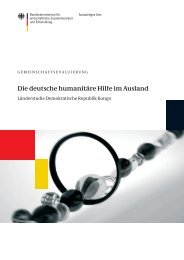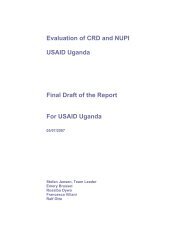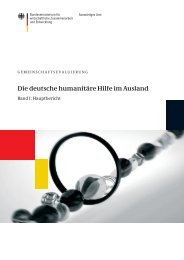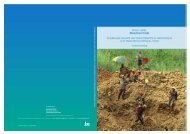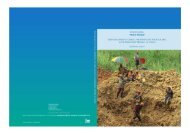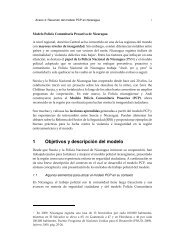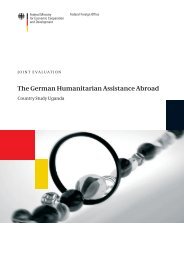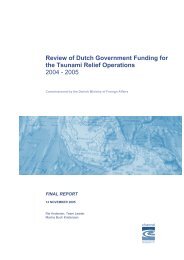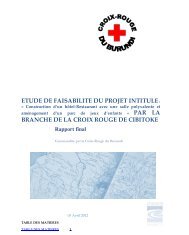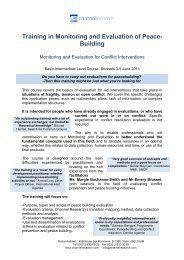A ripple in development? - Channel Research
A ripple in development? - Channel Research
A ripple in development? - Channel Research
Create successful ePaper yourself
Turn your PDF publications into a flip-book with our unique Google optimized e-Paper software.
The f<strong>in</strong>d<strong>in</strong>g is that the donors have been unable to l<strong>in</strong>k disaster<br />
response with <strong>development</strong> plans when those <strong>development</strong> plans have<br />
fallen ‘outside of the box’, i.e., where those places suffer<strong>in</strong>g from chronic<br />
marg<strong>in</strong>alisation receive less assistance because they are not national<br />
<strong>development</strong> priorities. There is a de facto triage, even where there is a<br />
huge amount of resources available.<br />
As f<strong>in</strong>ancial aid flows are recorded under the economic <strong>development</strong><br />
sector budget l<strong>in</strong>e, it is extremely difficult to trace how this aid is<br />
transmitted to households for livelihoods recovery. This is because at the<br />
macro level, this sector has many <strong>in</strong>dicators as def<strong>in</strong>ed by the national<br />
government and covers many types of <strong>in</strong>terventions. Also it is difficult<br />
to make a dist<strong>in</strong>ction between public-private partnerships. In general,<br />
most of these <strong>in</strong>terventions are categorised <strong>in</strong> terms of large scale reconstruction<br />
programmes which can be justified as provid<strong>in</strong>g public goods<br />
for economic activities, be it small scale or large scale. But these reconstruction<br />
<strong>in</strong>terventions do not directly create outcomes that can be<br />
traced to the households met dur<strong>in</strong>g the survey (for which sampl<strong>in</strong>g had<br />
been extensive).<br />
3.4 Roles of NGOs for livelihoods <strong>in</strong> Aceh and Nias<br />
As per the LRRD2 quantitative survey, the highest percentage of<br />
respondents, 21%, stated that they rely on friends and relatives for<br />
secur<strong>in</strong>g jobs. Aid agencies and their programmes were not named as<br />
be<strong>in</strong>g the ma<strong>in</strong> source of job creation. As such, it can be argued that<br />
while reconstruction programmes are conducive to job creation, it is<br />
market mechanisms and private <strong>in</strong>itiatives that determ<strong>in</strong>e whether <strong>in</strong>dividuals<br />
can secure jobs This is regardless of whether these jobs can be<br />
susta<strong>in</strong>ed <strong>in</strong> the long term or are just related to day-to-day casual labour.<br />
This is because the labour market rema<strong>in</strong>s severely under-developed <strong>in</strong><br />
terms of the number of firms available to generate demand for wage<br />
labour.<br />
Us<strong>in</strong>g the livelihood group history approach, some light can be<br />
shed on the macro-micro level economic <strong>development</strong>/household livelihood<br />
relationship. The follow<strong>in</strong>g f<strong>in</strong>d<strong>in</strong>gs are thus used to address the<br />
question “what are the perspectives of the household concern<strong>in</strong>g efforts<br />
made to support its livelihood recovery?”<br />
When collect<strong>in</strong>g the household histories, attempts were made to<br />
trace patterns of household <strong>in</strong>come generat<strong>in</strong>g activities and consumption,<br />
as well as seasonal factors that <strong>in</strong>fluence livelihood activities e.g.<br />
harvest<strong>in</strong>g. But these attempts were by and large unsuccessful as households<br />
were not able to recall livelihood changes <strong>in</strong> a l<strong>in</strong>ear manner, <strong>in</strong><br />
other words what change first happened <strong>in</strong> 2005, and then <strong>in</strong> 2006, and<br />
so forth. The household histories were consequently recorded <strong>in</strong> a nonl<strong>in</strong>ear<br />
manner.<br />
62



